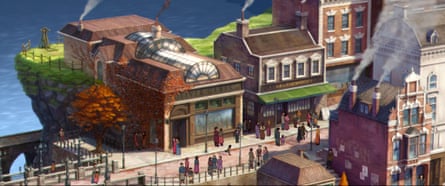The Glassworker began as an “impossible dream” and, like every impossible dream, its existence is a testament to the grit and grind of those who willed it to life. They are the artists at Mano Animation Studios, whose co-founder Usman Riaz is the director, animator and co-composer behind Pakistan’s first hand-drawn animated feature.
The titular glassworker is Vincent Oliver, voiced by Teresa Gallagher as a child and Sacha Dhawan as an adult. With his father, Tomas (Art Malik), he works at the finest glass workshop in Waterfront town. But as war breaks out over the sovereignty of the Great Ravine, their treasured storefront comes under threat. Amid it all a budding romance sparks between Vincent and Alliz Amano (Anjli Mohindra), a talented violinist who turns out to be the daughter of the colonel who has turned their quaint town into a warfront.
Most of the story unfolds in the form of childhood memories, as Vincent and Alliz grow up under the looming threat of war and try to hold on to their friendship, art and innocence, all of which are impacted by their fathers’ beliefs.
Every hand-drawn frame is handled with the utmost care, much like Vincent and Tomas handling the molten glass. In an early sequence, we see the glass-making process in detail as young Vincent empties his lungs into the blowpipe to form a sculpture’s final shape; breathing life into it, in a sense. This metaphor is the core of The Glassworker: just like the glass sculpture, beautiful things take a lot of effort to form – but can shatter at just a slight touch. Later in the film, the glass sculpture breaks, foreshadowing the corruption that befalls the glassworks as Alliz’s father, Colonel Amano (Tony Jayawardena), coerces Tomas into helping build the army’s warships.
Much like Tomas, Amano is a disciplinarian. His battle planes cast ghastly shadows over the lush green fields where Vincent and Alliz play, souring their blossoming companionship. As the story progresses, quiet and subtle moments reveal Amano’s tragedy. Like Vincent and Tomas, he, too, has an appreciation for the arts. He loves Alliz’s music and, more importantly, he loves her. But war drives him away from his daughter and his sensibilities. We see him at home in a red armchair, broken and tired, underneath a family portrait in which his father, a decorated general, is sitting in the same chair. Father and son are, in their own ways, also victims of the ruthless cycle of war.

The Glassworker’s anti-war sentiment and its hand-drawn animation call to mind the works of Studio Ghibli’s Hayao Miyazaki. The film’s aesthetics possess the same emotional resonance and attention to detail that are part of Miyazaki’s distinctive style. Even the romantic score is reminiscent of Joe Hisaishi’s iconic compositions for Ghibli films. But while The Glassworker’s exploration of the hereditary nature of ideals is compelling the film’s anti-war philosophy and presentation lack the nuance that is a staple of Miyazaki’s works.
Still, Riaz’s debut feature is not without glimmers of brilliance. Aside from being a landmark in the history of Pakistani cinema, what sets The Glassworker apart from its inspirations is the rich and vibrant world of Waterfront, partly influenced by Riaz’s hometown of Karachi. Although it is difficult to tell if the moral values The Glassworker tries to impart will be remembered, few will forget the bustling market Tomas and Vincent walk through, where the little glassworker is treated to one of the mouth-watering gulab jamuns that sparkle in a pot.
-
The Glassworker is available to stream on SBS On Demand in Australia, with UK and US streamers yet to be announced. For more recommendations of what to stream in Australia, click here
Source: theguardian.com


